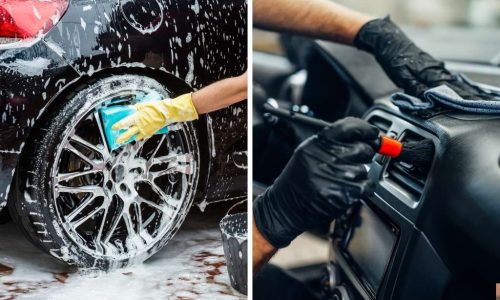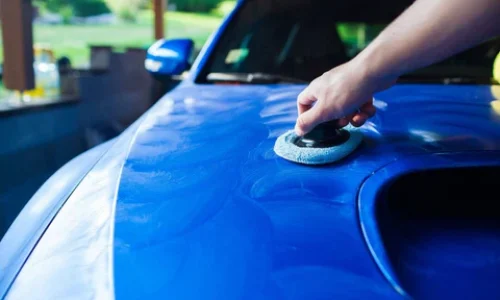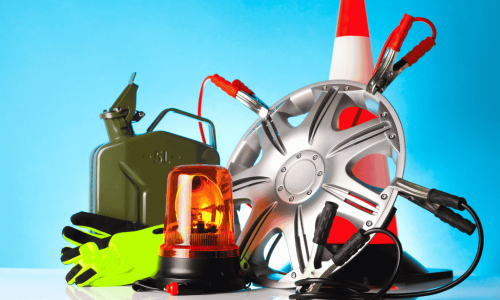Seeing your car shine as if it had just rolled off the showroom floor gives you a feeling you’ll never forget. However, if your vehicle looks more like a pathetic machine than a sleek one, you should break out the polishing compound. Tar and other caked-up grime accumulate over time regardless of how careful you are while driving, making your car’s paintwork look dull and weathered. Fortunately, buffing a car with the compound can easily remove these general signs of ageing on cars as well as more severe imperfections, such as scratches and paint transfer. They help restore the shine and smoothness of your vehicle. So, are you ready to learn how to compound a car and make it sparkle? Here’s our complete guide.
Understanding Compound Polishing Basics
As the name implies, car compounding is the process of restoring damaged surfaces of the car paintwork by using specially formulated products designed to enhance the appearance of your vehicle. Compounds for cars are capable of smoothing & restoring clearcoat layers due to their abrasive properties. There are various types of compounds used for your Vehicle.
Polishing Compound VS. Rubbing Compound
Choosing the right compound can be confusing for many people because of their different nature
- Polishing compounds are less abrasive and are used to enhance paint finishes and increase shine. Despite their ability to remove light scratches, they won’t be able to remove deep scratches.
- Rubbing compounds have hard abrasives in larger particle sizes, resulting in a more aggressive formula that can smooth out severe scratches and restore greater damage to the surface.
When Do You Need To Use A Polishing Compound?
While rubbing compounds serve as a heavy-duty scrubber, polishing provides gentle touch-up to vehicles. Keeping your car’s exterior clean requires both processes, but knowing which to use when is crucial.
In addition to cleaning a vehicle’s paint surface and shining it, polishing compounds remove small imperfections. You can use them for:
- Removing light scratches
- Removing watermarks from paint or glass (if window cleaners fail)
- Cleaning most automotive finishes by removing stains or light oxidation
If you want to refine the shine of your paint and protect it, follow a polishing compound treatment with a car polish or car wax.
What Is The Best Time To Use A Rubbing Compound?
When milder formulas fail to remove more severe paint damage, rubbing compound is recommended. This includes:
- Removal of stubborn stains and severe oxidation
- Getting rid of paint transfer
- Repairing deeper scratches and scuffs
When restoring new car paintwork, avoid using rubbing compounds. Make sure to use it only after testing less aggressive products.
Essential Tools and Materials
Let’s prepare your toolbox before you begin. You will need the following tools and materials for optimal results:
1. A Dual-Action Polisher: Compounding efficiently and consistently requires a dual-action polisher. It is the best car polisher for beginners and professionals alike due to its oscillating motion, which reduces the risk of damaging the paint.
2. Compounding pads: Compounding pads should be attached to your polisher. The foam pads are good at evenly distributing the compound and removing defects.
3. Polishing compound: Make sure to select a high-quality polishing compound that is designed to correct paint defects. It’s the best compound for scratches and enhances your car’s appearance.
4. Microfiber towels: Microfiber towels can be used for wiping off excess compound and buffing surfaces to a high shine. They prevent scratching during the process because of their soft texture.
5. Detailing brushes: To ensure a thorough and uniform finish, use detailing brushes to clean intricate areas.
6. Clay bar kit: A clay bar should be used before compounding to remove embedded contaminants. To maximize the effectiveness of the compound, it is essential to clean the surface before applying the compound.
7. Protective Gear: Use protective gloves and glasses. The compounding process can harm your skin and eyes if you are not wearing protective gear.
You’ll be well prepared to compound your car effectively, enhancing its appearance and preserving its paintwork with these tools and materials.
Preparing Your Car for Polishing
Polishing your car properly is crucial to achieving optimal results and preserving the paintwork of your car. Follow this step-by-step guide to get started:
1. Wash the car thoroughly.
The first step is to wash your car so that you can remove surface dirt and grime. For best results, use a pH-balanced car shampoo and a microfiber wash sponge. Using a microfiber towel, dry thoroughly after rinsing. Utilize Tarkeeb Wa Tarteeb Auto Care’s car wash services to clean your car & parts you wish to clean.
2. Use clay bars to remove contamination
Use a clay bar after washing to remove embedded contaminants such as tar, sap, and industrial fallout. Use clay lubricant to lubricate the paint surface before applying the clay bar over it. The paint is now smooth and ready to be polished.
3. Mask delicate areas
Use masking tape to protect sensitive parts of your car, such as rubber trims and plastic mouldings.Tape should be applied evenly and pressed firmly along the edges to prevent polish seepage, and it should be removed carefully to avoid leaving residue or damaging surfaces. In this way, accidental damage caused by polishing can be prevented.
4. Choose the Right Polishing Products
Depending on the condition of your car’s paint, choose the right polishing compound and pad combination. Using a soft pad and mild polish will suffice for minor imperfections. More abrasive compounds and pads may be needed for deeper scratches.
5. Test a small area first
It is important to test your polish and pad on a small, non-visible area before using them on the entire car. By doing this, you ensure compatibility and determine whether the combination is effective.
6. Begin the Polishing Process
Use a small amount of polish on the pad and work on one section at a time. You can use a dual-action polisher or work by hand, applying even pressure and overlapping passes. Keep the pad flat to avoid swirl marks.
7. Wipe Off residual
Wipe off any residue with a clean microfiber towel after polishing each section. In this way, you can inspect the results and ensure a uniform finish.
8. Apply a protective wax or sealant
To protect the freshly polished surface, apply a wax or paint sealant once the polishing has been completed. It enhances the shine and adds a layer of protection.
If you follow these steps, you will ensure your paint is protected longer and your car receives a smoother, glossier finish.
Conclusion:
Polishing your car with a polishing compound is essential to maintaining its glossy appearance and protecting its paint. It is possible to restore and enhance the exterior of your car by understanding the difference between polishing and rubbing compounds, selecting the right tools, and following the steps properly about how to buff a car. A polishing compound removes imperfections and brings out the vehicle’s vibrant shine, leaving a professional finish that enhances its appearance. At Tarkeeb Wa Tarteeb Auto Care, we’re here to help you with professional car detailing services in Dubai.
Frequently Asked Questions
Is rubbing compound bad for car paint?
When used correctly, rubbing compounds is not harmful to car paint. Overuse or improper application, however, can damage the clear coat.
How many times can you polish a car?
Ideally, polishing should be done 2-3 times a year. In the long run, excessive polishing can thin the paint.
Will rubbing compounds remove scratches?
You can remove scratches with rubbing compounds, especially deeper ones, but you should use them carefully.
What is the difference between polish and compound?
Polishes are less abrasive and enhance shine, while compounds are more abrasive and used for significant paint correction.
What is the best compound for removing scratches?
Meguiar’s or 3M products are high-quality compounds designed for paint correction.
How to polish a car with a machine?
Invest in a dual-action polisher that works in small sections for consistent and safe results.
How to apply polishing compound to a buffing wheel?
Apply a small amount of compound evenly to the pad or wheel, then work in overlapping passes.






